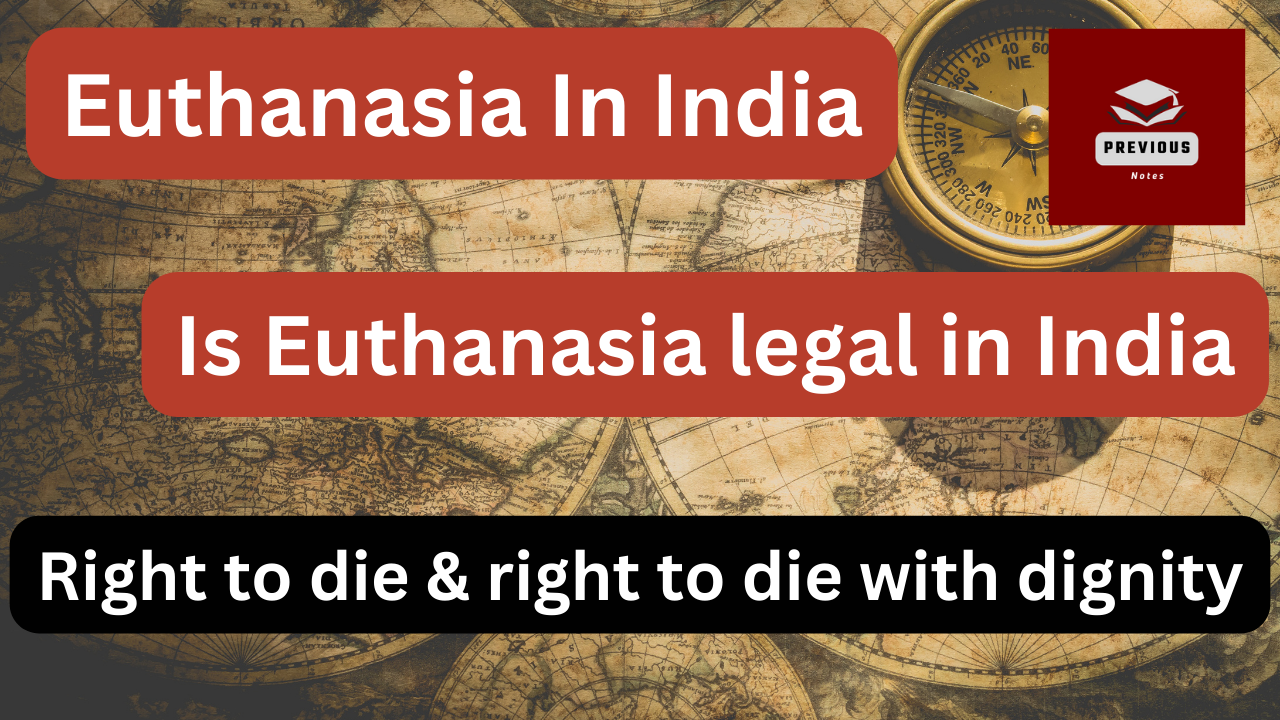Euthanasia in India
Definition of Euthanasia: Euthanasia drives from Greek word ‘eu’ and ‘thanatos’ which mean ‘easy death’.Euthanasia refers to the intentional act of ending someone’s life to relieve them from suffering, typically due to a terminal illness or a condition that causes significant pain and distress. This act is usually carried out by a medical professional or with their assistance.
Types of Euthanasia:
Passive Euthanasia:
Active Euthanasia:
- Definition: Active euthanasia involves deliberately taking steps to end a person’s life. This can include administering a lethal dose of medication or carrying out a medical procedure with the explicit purpose of causing the person’s death.
- Example: A doctor administering a lethal injection to a patient at the patient’s request.
Passive Euthanasia:
- Definition: Passive euthanasia involves allowing a person to die by withholding or withdrawing treatment that would artificially prolong their life. The intention is not to cause death directly but to let the natural course of events take place.
- Example: Withholding or withdrawing life support, such as turning off a ventilator or discontinuing medication, leading to the patient’s death.
Key differences between active and passive euthanasia include the directness of the action and the intention behind it:
Directness: Active euthanasia involves a direct, intentional act to bring about death, while passive euthanasia involves a withholding or withdrawing of treatment.
Intention: In active euthanasia, the intention is to cause death to relieve suffering. In passive euthanasia, the primary intention is to allow a natural death by refraining from medical interventions.
Legal Position of Euthanasia in India:
In India Passive euthanasia is legal that to subject to the guidelines but active euthanasia is illegal in India.
Euthanasia in Other Countries:
Euthanasia in all form Illegal:
- Many countries strictly prohibit euthanasia in all its forms. Examples include:
- Some countries in Africa, Russia
- Some European countries, such as Poland.
- Many countries strictly prohibit euthanasia in all its forms. Examples include:
Euthanasia Not Decided:
- In most of the countries, the legal status of euthanasia is not clearly defined, or there may be ongoing debates without specific laws. This can include:
- Some jurisdictions in Southeast Asia.
- Most countries in Africa.
- In most of the countries, the legal status of euthanasia is not clearly defined, or there may be ongoing debates without specific laws. This can include:
Passive Euthanasia Allowed:
- Some countries permit passive euthanasia under certain circumstances. Examples include:
- The United States (though the legality varies by state and is often influenced by specific cases and court decisions).
- Some European countries, such as the United Kingdom, where the withdrawal of life-sustaining treatment may be allowed under certain conditions.
- In India, Passive Euthanasia is allowed subject to the guidelines.
- Some countries permit passive euthanasia under certain circumstances. Examples include:
Both Active and Passive Euthanasia Allowed:
- A few countries have legalized both active and passive euthanasia under specific conditions. Examples include:
- The Netherlands.
- Belgium.
- Luxembourg.
- Canada.
- Colombia.
- A few countries have legalized both active and passive euthanasia under specific conditions. Examples include:
Right to Die & Right to Die with dignity
Right to die with dignity is a fundamental right under Article 21 of India Constitution. The right to die is not explicitly recognized as a fundamental right in the Indian Constitution. However, passive euthanasia is allowed in India. Moreover, Suicides are not legal in India. It was a punishable offence under sec. 309 of Indian Penal Code. For Right to die & Right to die with dignity, let’w discuss important case laws related to this topic:
P. Rathinam vs. Union of India (1994) :
Key points from the case:
Background:
- P. Rathinam, a lawyer, filed a Public Interest Litigation (PIL) challenging the constitutional validity of Section 309 of the IPC, which penalized individuals for attempting suicide.
Argument:
- The petitioner argued that the right to life guaranteed under Article 21 of the Indian Constitution also includes the right to die, and criminalizing attempted suicide violates this fundamental right.
Court’s Decision:
- The Supreme Court of India, in its judgment on 9 March 1994, struck down Section 309 of the IPC as unconstitutional. The court held that the right to life under Article 21 includes the right to die with dignity. Criminalizing suicide was deemed as arbitrary and unreasonable.
Reasoning:
- The court, in its judgment, emphasized the right to personal liberty and autonomy. It stated that an individual has the right to control his or her body, and the state should not interfere with personal choices that do not affect others.
Impact:
- The decision in the P. Rathinam case had a significant impact on the legal landscape concerning suicide in India. It marked a departure from the earlier view that attempted suicide could be penalized.
Gian Kaur vs. State of Punjab (1996):
- Background: The question arose about the constitutional validity of Section 306 of the IPC, which deals with abetment of suicide. The petitioner argued that if the attempt to commit suicide is not an offense (following the Rathinam judgment), then abetment to suicide should also not be considered a crime.
- Judgment: The Supreme Court, in the Gian Kaur case, held that the right to life does not include the right to die, and therefore, abetment to suicide (Section 306) was not violative of Article 21.
- Outcome: While the court upheld the constitutionality of Section 306, it clarified that the decision in Rathinam regarding Section 309 did not extend to decriminalizing abetment to suicide.
Aruna Ramchandra Shanbaug vs. Union of India (2011)
Background:
- Aruna Shanbaug had been in a vegetative state since 1973, following a sexual assault that left her in a coma.
- In 2009, journalist Pinki Virani filed a petition seeking euthanasia for Aruna Shanbaug, arguing that her continued existence in a vegetative state was a violation of her right to live with dignity.
Judgment:
- The Supreme Court of India, in its judgment in March 2011, rejected the plea for euthanasia but issued guidelines regarding passive euthanasia.
- The court held that passive euthanasia could be permitted under certain conditions and laid down guidelines for the same. It differentiated between active euthanasia (which involves a specific act to end life) and passive euthanasia (withholding or withdrawing life-sustaining treatment).
- The court allowed the withdrawal of life support to patients in a permanent vegetative state or those in irreversible coma, but only after obtaining permission from the High Court concerned.
Significance:
- The Aruna Shanbaug case marked a significant development in the legal understanding of euthanasia in India. It clarified the legal position on passive euthanasia while maintaining that active euthanasia remained illegal.
- The judgment also highlighted the importance of individual autonomy, especially in cases where patients were in a persistent vegetative state with no hope of recovery.
Common Cause (A Regd. Society) vs. Union of India (2018)
Background:
- The petition was filed by the non-governmental organization Common Cause, seeking the recognition of the right to die with dignity as a fundamental right.
- The case primarily dealt with the issue of passive euthanasia and the right of individuals to create advance directives or ‘living wills’ specifying their wishes regarding medical treatment in case they become terminally ill and unable to communicate.
Judgment:
- The Supreme Court, in its judgment on March 9, 2018, recognized the right to die with dignity as a fundamental right protected under Article 21 (right to life and personal liberty) of the Constitution of India.
- The court allowed the creation of advance directives by individuals, specifying the medical treatments they would want or not want in case they reach a point of no return in a terminal illness.
- It laid down guidelines and safeguards for the execution of advance directives, ensuring that they are recorded, transparent, and followed with due regard to the patient’s autonomy.
Key Points:
- The court distinguished between active euthanasia (which involves a positive act to end life) and passive euthanasia (withholding or withdrawing medical treatment).
- The judgment emphasized the right to live with dignity and autonomy, allowing individuals to refuse medical treatment in certain conditions.
- The recognition of the living will provided a legal framework for individuals to express their wishes regarding end-of-life care.


















Leave a Reply